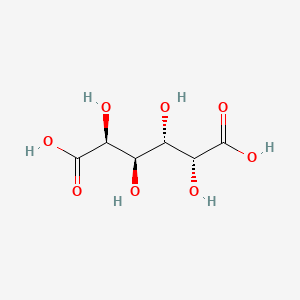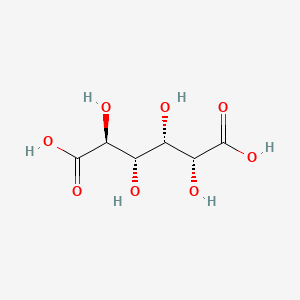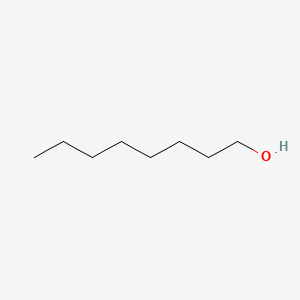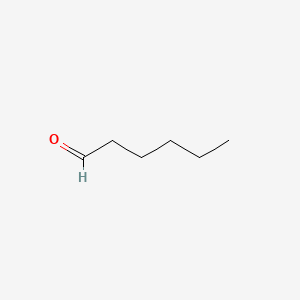
|
Galactaric acid |
Galactaric acid is a lipid of Fatty Acyls (FA) class. Galactaric acid is associated with abnormalities such as Dehydration. The involved functions are known as Biochemical Reaction, Citric Acid Cycle and galactarate dehydratase activity. Galactaric acid often locates in Protoplasm and Back. The associated genes with Galactaric acid are CNGB1 gene, P4HTM gene, Genes, Bacterial and HPX gene. |
260 |

|
Glucaric acid |
Glucaric acid is a lipid of Fatty Acyls (FA) class. Glucaric acid is associated with abnormalities such as Consumption-archaic term for TB and furuncle. The involved functions are known as Oxidation, Mutation, Process, Cell Growth and Anabolism. Glucaric acid often locates in BL21, Clone and host. The associated genes with Glucaric acid are MIOX gene, ISYNA1 gene, Genome and Candidate Disease Gene. The related experimental models are Knock-out. |
1814 |

|
11beta-PGF2 |
11beta-pgf2 is a lipid of Fatty Acyls (FA) class. |
15009 |

|
n-octanol |
N-octanol is a lipid of Fatty Acyls (FA) class. N-octanol is associated with abnormalities such as Wiskott-Aldrich Syndrome. The involved functions are known as Mutation and Detergents. N-octanol often locates in Tissue membrane. The related lipids are Octanols and 1-Octanol. |
3305 |

|
4-hydroxynonenal |
4-hydroxynonenal is a lipid of Fatty Acyls (FA) class. 4-hydroxynonenal is associated with abnormalities such as Chronic disease, Obesity, Diabetes, Acquired Immunodeficiency Syndrome and Lung diseases. The involved functions are known as protein expression, Glycolysis, mRNA Expression, Regulation and Mitochondrion in division. 4-hydroxynonenal often locates in Muscle, Mitochondria, Adipose tissue, Head and Mouse Muscle. The associated genes with 4-hydroxynonenal are STAT3 gene, SIRT1 gene, PGC gene, IL6 gene and cytochrome c''. The related lipids are Lipopolysaccharides, Lipid Peroxides, Promega, Membrane Lipids and oxidized lipid. The related experimental models are Mouse Model, Knock-out, Transgenic Model, Disease model and Rodent Model. |
5685 |

|
Caproaldehyde |
Caproaldehyde is a lipid of Fatty Acyls (FA) class. The related lipids are erucic acid. |
1265 |

|
PE(15:0/20:0) |
PE(15:0/20:0) is a lipid of Glycerophospholipids (GP) class. Pe(15:0/20:0) is associated with abnormalities such as Exanthema, Infection, Painful Bladder Syndrome, Obesity and Fatty Liver. The involved functions are known as conjugation, Transcription, Genetic, Sinking, Autophagy and Protein Biosynthesis. Pe(15:0/20:0) often locates in membrane fraction, soluble, Membrane, Body tissue and Tissue membrane. The associated genes with PE(15:0/20:0) are GABARAPL2 gene, ATG10 gene, ATG12 gene, SLC33A1 gene and GABARAP gene. The related lipids are Liposomes, Lipopolysaccharides, Phosphatidylserines, Membrane Lipids and Cardiolipins. The related experimental models are Knock-out and Cancer Model. |
723 |

|
minocycline |
minocycline is a lipid of Polyketides (PK) class. Minocycline is associated with abnormalities such as Infection, Soft Tissue Infections, Septicemia, Chronic hyponatremia and Lesion of brain. The involved functions are known as Pharmacodynamics, Gene Expression, Transcriptional Activation, Regulation and Process. Minocycline often locates in Ribosomes, 50S ribosomal subunit, Blood, Skin and Immune system. The associated genes with minocycline are THEMIS gene, KCNK2 gene, RBFOX3 gene, PIWIL2 gene and P4HTM gene. The related lipids are Lipopolysaccharides, Promega, Steroids, Liposomes and Octanols. The related experimental models are Mouse Model, Experimental Autoimmune Encephalomyelitis, Genetically Engineered Mouse, Disease model and spinal model. |
9780 |

|
rotenone |
rotenone is a lipid of Polyketides (PK) class. Rotenone is associated with abnormalities such as Parkinson Disease, MYOPATHY, DISTAL, WITH ANTERIOR TIBIAL ONSET, Neurodegenerative Disorders, Septicemia and Respiratory Failure. The involved functions are known as Phosphorylation, Process, Cell Death, proteasome activity and Apoptosis. Rotenone often locates in Protoplasm, Presynaptic Terminals, Neurites, NADH dehydrogenase complex and Mitochondria. The associated genes with rotenone are DNAJB9 gene, EIF2S3 gene, Candidate Disease Gene, G-substrate and ERN1 gene. The related lipids are Lipopolysaccharides, Membrane Lipids, Phosphatidylserines, Fatty Acids and Cardiolipins. The related experimental models are Knock-out, Mouse Model, Disease model and Rodent Model. |
7079 |

|
quercetin |
quercetin is a lipid of Polyketides (PK) class. Quercetin is associated with abnormalities such as Coronary heart disease, Myocardial Infarction, Cirrhosis, Coronary Arteriosclerosis and Vascular ring. The involved functions are known as Vasodilation, physiological aspects, Fermentation, Process and Ingredient. Quercetin often locates in Arterial system, Endothelium, Skin, Endothelium, Vascular and Tissue specimen. The associated genes with quercetin are P4HTM gene, SULT gene, UGT1A1 gene, ARHGAP26 gene and PLXNB1 gene. The related lipids are blood lipid, Promega, Steroids, Phosphatidylserines and Fatty Acids. The related experimental models are Knock-out, Mouse Model, Xenograft Model, Tissue Model and Cancer Model. |
5377 |









